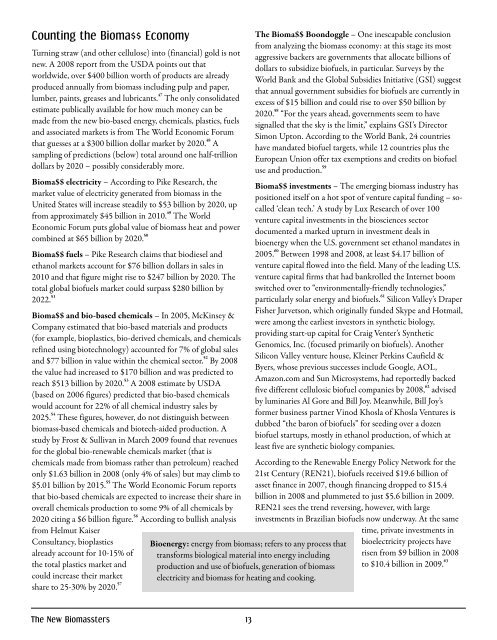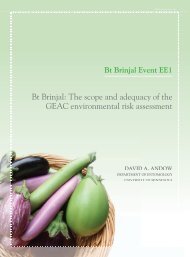English - pdf - 2145 Kb - Biosafety Information Centre
English - pdf - 2145 Kb - Biosafety Information Centre
English - pdf - 2145 Kb - Biosafety Information Centre
- No tags were found...
Create successful ePaper yourself
Turn your PDF publications into a flip-book with our unique Google optimized e-Paper software.
Counting the Bioma$$ EconomyTurning straw (and other cellulose) into (financial) gold is notnew. A 2008 report from the USDA points out thatworldwide, over $400 billion worth of products are alreadyproduced annually from biomass including pulp and paper,lumber, paints, greases and lubricants. 47 The only consolidatedestimate publically available for how much money can bemade from the new bio-based energy, chemicals, plastics, fuelsand associated markets is from The World Economic Forumthat guesses at a $300 billion dollar market by 2020. 48 Asampling of predictions (below) total around one half-trilliondollars by 2020 – possibly considerably more.Bioma$$ electricity – According to Pike Research, themarket value of electricity generated from biomass in theUnited States will increase steadily to $53 billion by 2020, upfrom approximately $45 billion in 2010. 49 The WorldEconomic Forum puts global value of biomass heat and powercombined at $65 billion by 2020. 50Bioma$$ fuels – Pike Research claims that biodiesel andethanol markets account for $76 billion dollars in sales in2010 and that figure might rise to $247 billion by 2020. Thetotal global biofuels market could surpass $280 billion by2022. 51Bioma$$ and bio-based chemicals – In 2005, McKinsey &Company estimated that bio-based materials and products(for example, bioplastics, bio-derived chemicals, and chemicalsrefined using biotechnology) accounted for 7% of global salesand $77 billion in value within the chemical sector. 52 By 2008the value had increased to $170 billion and was predicted toreach $513 billion by 2020. 53 A 2008 estimate by USDA(based on 2006 figures) predicted that bio-based chemicalswould account for 22% of all chemical industry sales by2025. 54 These figures, however, do not distinguish betweenbiomass-based chemicals and biotech-aided production. Astudy by Frost & Sullivan in March 2009 found that revenuesfor the global bio-renewable chemicals market (that ischemicals made from biomass rather than petroleum) reachedonly $1.63 billion in 2008 (only 4% of sales) but may climb to$5.01 billion by 2015. 55 The World Economic Forum reportsthat bio-based chemicals are expected to increase their share inoverall chemicals production to some 9% of all chemicals by2020 citing a $6 billion figure. 56 According to bullish analysisfrom Helmut KaiserConsultancy, bioplasticsalready account for 10-15% ofthe total plastics market andcould increase their marketshare to 25-30% by 2020. 57Bioenergy: energy from biomass; refers to any process thattransforms biological material into energy includingproduction and use of biofuels, generation of biomasselectricity and biomass for heating and cooking.The Bioma$$ Boondoggle – One inescapable conclusionfrom analyzing the biomass economy: at this stage its mostaggressive backers are governments that allocate billions ofdollars to subsidize biofuels, in particular. Surveys by theWorld Bank and the Global Subsidies Initiative (GSI) suggestthat annual government subsidies for biofuels are currently inexcess of $15 billion and could rise to over $50 billion by2020. 58 “For the years ahead, governments seem to havesignalled that the sky is the limit,” explains GSI’s DirectorSimon Upton. According to the World Bank, 24 countrieshave mandated biofuel targets, while 12 countries plus theEuropean Union offer tax exemptions and credits on biofueluse and production. 59Bioma$$ investments – The emerging biomass industry haspositioned itself on a hot spot of venture capital funding – socalled‘clean tech.’ A study by Lux Research of over 100venture capital investments in the biosciences sectordocumented a marked upturn in investment deals inbioenergy when the U.S. government set ethanol mandates in2005. 60 Between 1998 and 2008, at least $4.17 billion ofventure capital flowed into the field. Many of the leading U.S.venture capital firms that had bankrolled the Internet boomswitched over to “environmentally-friendly technologies,”particularly solar energy and biofuels. 61 Silicon Valley’s DraperFisher Jurvetson, which originally funded Skype and Hotmail,were among the earliest investors in synthetic biology,providing start-up capital for Craig Venter’s SyntheticGenomics, Inc. (focused primarily on biofuels). AnotherSilicon Valley venture house, Kleiner Perkins Caufield &Byers, whose previous successes include Google, AOL,Amazon.com and Sun Microsystems, had reportedly backedfive different cellulosic biofuel companies by 2008, 62 advisedby luminaries Al Gore and Bill Joy. Meanwhile, Bill Joy’sformer business partner Vinod Khosla of Khosla Ventures isdubbed “the baron of biofuels” for seeding over a dozenbiofuel startups, mostly in ethanol production, of which atleast five are synthetic biology companies.According to the Renewable Energy Policy Network for the21st Century (REN21), biofuels received $19.6 billion ofasset finance in 2007, though financing dropped to $15.4billion in 2008 and plummeted to just $5.6 billion in 2009.REN21 sees the trend reversing, however, with largeinvestments in Brazilian biofuels now underway. At the sametime, private investments inbioelectricity projects haverisen from $9 billion in 2008to $10.4 billion in 2009. 63The New Biomassters 13











